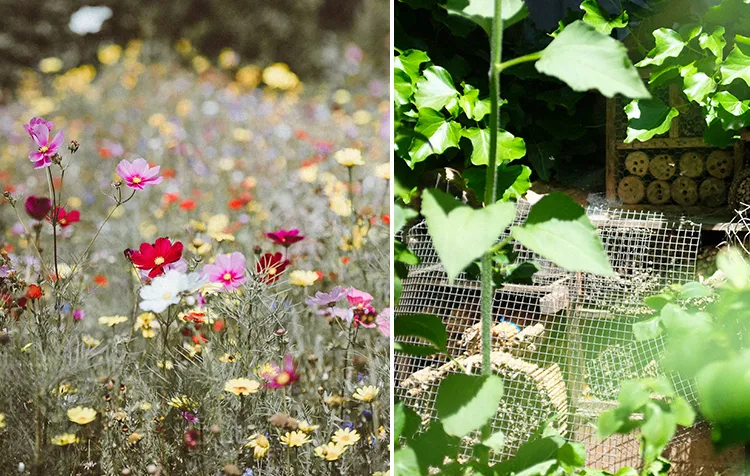You want to create a wildflower meadow in the garden or simply design a natural, wild corner where birds, insects and other garden animals feel at home? Then you've come to the right place! In today's world, where many natural habitats are threatened, even a small, wild corner in the garden can make a real difference. A wildflower meadow or a natural corner can not only inspire visually, but also offers numerous animals a versatile habitat and safe retreat.
In this article I would like to show you how you can create a piece of wilderness in your garden with simple means and experience the diversity of nature right on your doorstep. Let's go!
Here you can find a short overview in advance:
Definition: What do we even mean by a wildflower meadow and a wild corner?
A wildflower meadow or wildflower corner is an area in the garden where native wildflowers, grasses and herbs grow and where the Nature pretty freely unfold can. In a "wild corner", the near-natural mini biotope with wild plants is supplemented with, among other things, bird and insect-friendly Sheltering facilities and the appropriate food supply.
So the concept of such areas left to nature in the garden is the Counterpart to the conventionally maintained gardens with often exotic plant species, a lot of gravel and perfectly mowed lawns. Wild corners are maintained less intensively or almost not at all. This also makes them beautiful, just differently beautiful. For many people, they take some getting used to, but beautiful. Messy and uniquely beautiful - and beautifully alive!
Advantages: Why create a wildflower corner?
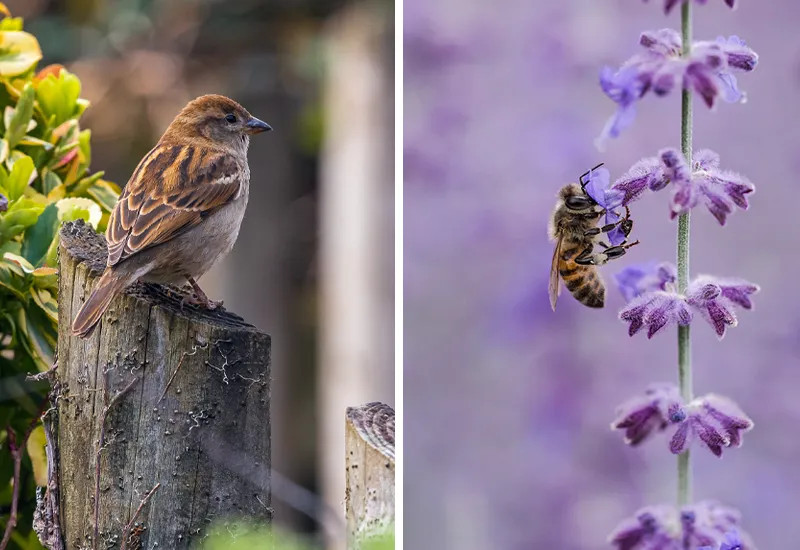
What is the case for such a wild corner - why even venture into this garden project? For the necessary motivation to create a wildflower corner in your own garden, I would now like to present to you - briefly and concisely - the most important advantages:
- Promoting biodiversity: The wild area in the garden creates habitat and food sources for a variety of birds, wild bees, butterflies as well as many other insects and small animals that often no longer find suitable living conditions in slick (gravel) gardens or even on other (sealed) land areas. Whoever wants to protect the global Stop species extinction wants, so be sure to create a wildflower corner.
- Less maintenance required: Natural, wild corners rely on the natural balance in ecosystems. For example, wild plants are adapted to local climatic conditions and also do not require intensive watering. Once established, as a wild garden owner:in you can sit back and enjoy the goings-on, as your greenery requires less regular maintenance than "modern" gardens.
- Natural protection: The deep roots of many wildflowers improve soil structure and counteract erosion and drying. In addition, the diversity of plants and animals in your wildflower meadow can help you do this, Control pests naturally and sustainably.
- Better pollination performance: More and more bees, butterflies and other pollinators benefit from the living conditions your wildflower corner offers them. For example, they contribute to the Crop pollination in the surrounding area and thus also promote, among other things, the yield of fruit and vegetables from their own gardens.
- Absolute recovery: With a natural garden area, you'll create a vibrant place of relaxation in your home. Enjoy the ever-changing color palette of wildflowers and the lively activity of birds, butterflies, bees and dragonflies simply from the hammock.
Can you think of any other benefits of having a wildflower corner in your own backyard? Then look forward to your ideas and experiences in the comments.
10 tips: What should you consider when creating a wildflower corner?
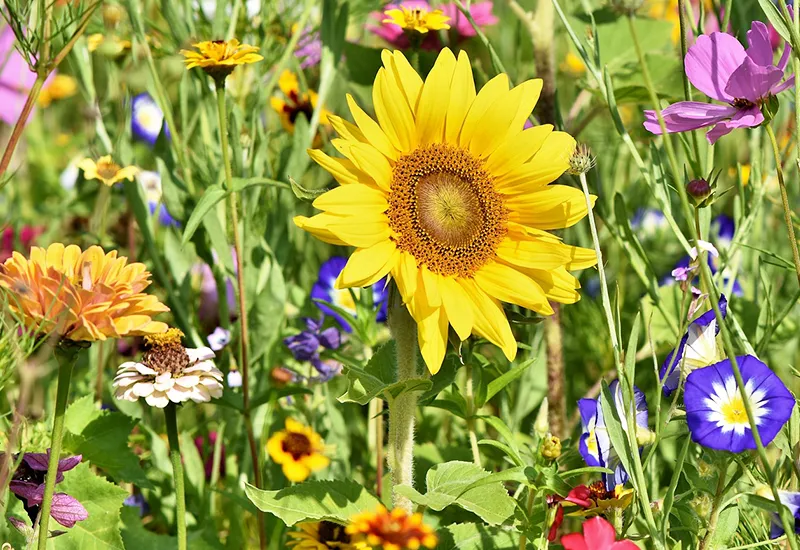
Now you know why wildflower meadows and wild corners in the garden are so incredibly valuable and exciting. But even though you can basically let nature run wild, there are some Planning and implementation Of course, there are a few things you should be aware of.
The following tips should help you get the most out of your wildflower corner and turn it into a Paradise of biodiversity to transform.
1. sow native wildflowers
We'll start with the obvious: if you want to create a species-rich wildflower meadow in your backyard, you'll need to sow wildflowers that are native to your area. They are perfectly adapted to the climatic conditions on site and an essential food source for many insects.
However, please avoid the "ready mixes" from the classic supermarket and instead prefer packages that contain only seeds from plants grown in the region. Because according to the German Federal Foundation for the Environment there are 22 areas of origin for regional indigenous seed in Germany.
You can recognize the respective packs by the VWW Certificationwhich identifies regio seed according to strict standards pursuant to Section 40 (4) of the German Federal Nature Conservation Act (BNatschG). The "Regiozert" seal is also a reliable identifier.
Alternatively, you can also use wild plants in your surroundings Scan with a special smartphone app (e.g. GoogleLens) and make targeted repurchases.
But you can get your wildflowers even more cheaply - and definitely regionally - if you use different seasons to gather ripe flower seeds from wild field meadows and sow them in your (future) wild corner in the garden. The attracted birds will then also eventually add many more, regional seeds, without you having to do or spend anything.
2. supplement wild corner with animal friendly plants
Expand your Wildflower corner in the garden through animal-friendly trees, shrubs, bushes and flowers. Not only do they encourage animal pollination, but they also provide shelter and food for countless insects and birds. By thoughtfully combining them with wildflowers, you can thus enhance the Promote biodiversity in a targeted manner.
Here I have listed some plants that are ideal for a wild garden corner.
Insect and bird friendly trees and shrubs
- Serviceberry (real or Swedish)
- Mountain ash (rowan)
- Rock pear
- Elderberry
- Speierling
- Cornelian cherry
- Two-ribbed hawthorn
- Common juniper
- Hazel
- Willows
- Dog Rose
- Blackberries
- Summer Lilac
- …
Insect and bird friendly perennials and flowers
- Sweet Clover
- Wild cardoon
- Common thistle
- Forest angelica
- Sunflower
- Wood anemone
- Daisies
- Aster
- …
Tip: It is best to arrange the plants directly so that there is always a food supply available for your garden animals from spring to fall.
3. offer sandy places
An unvegetated sand bed is a truly ideal habitat for many species of wild bees and other insectswhich build their nesting holes on the ground. The sandy area, for example, can be closed off very well with a homemade wicker fence or old, narrow tree trunks.
Also, of course, many birds (especially sparrows) are pleased with a soothing Sand bath. They use the sand to rid their feathers of mites and other parasites. If you want to make it easier for them to groom themselves, you should therefore place sand in your wildflower corner - in addition to the Sandarium - also a shallow bowl with sand set up for the birds.
4. deadwood logs and Brushwood pile lay down
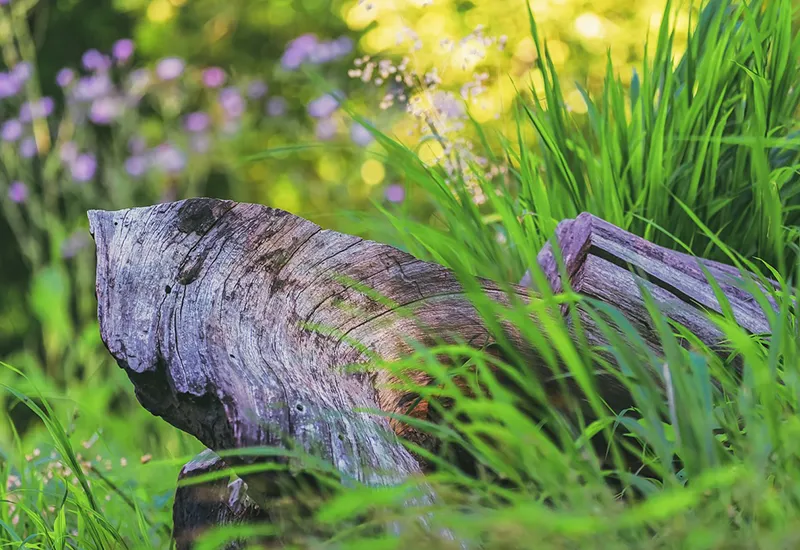
A deadwood log or a deadwood or brushwood pile Offers a habitat for numerous animal species - both in summer and winter. For example, toads, slow worms, lizards, birds or countless insects look for Protection under the wood. They also find there abundant Food and can even use the wood as building material for their own dwellings.
So, for example, use the old trunk of a fallen tree to give it a new task in the garden. To create a pile of brushwood, for example, you can use its Branches or also general Fruit tree pruning pile up. Both can also be easily transformed with the help of a few wooden pillars into a piled hedge which additionally serves as a structured border or demarcation in the domestic greenery.
Tip: If you have the possibility, prefer the old trunk of a deciduous tree, such as an ash, oak or beech. There you can also drill holes in which insects can lay their larvae. Holes in coniferous wood are unfortunately usually too sharp-edged, so that bees and other animals could injure their wings.
5. place birdbaths and birdbaths
Both bees, dragonflies and butterflies - but especially birds - are among the constant visitors of a drinking bowl in the garden paradise. The latter always need clean, fresh water - not only for drinking, but also for bathing.
It is best to place one flat clay bowl as a birdbath and bird bath, and as an insect watering hole. Help bees, bumblebees and co but necessarily with small woods and stones in the shell, so that they can land well, hide a little and, in an emergency, get out of the water themselves.
Birds just want a bowl of water - and some free space around it, so that they can not be surprised by predators.
6. create piles of leaves and stones
Instead of disposing of leaves in the organic garbage can, focus on their ecological value in your wild corner of the garden. Piles of leaves covered with a few branches, for example, provide a source of Insects, hedgehogs and other garden animals ideal conditions to survive the cold winter safely and always warmed. In addition, the foliage becomes new soil.
Tip: Just do without expensive and hearty little environmentally friendly leaf blowers and leaf vacuums. Not only are they noisy and smelly, but they also deprive the animals of what they thought were safe winter quarters.
It is also advisable to protect hedgehogs - as well as lizards, slow worms and many other animals - with a Cairn help you further. This definitely can not blow away and, when overgrown with mosses and grasses, is a real magnet for spiders, butterflies, snails and many other garden inhabitants.
7. build insect hotel yourself
An insect hotel in a sunny place protected from wind and rain in your wildflower corner, provides ideal nesting conditions for numerous insects. Bumblebees, wild bees, wrinkled wasps, hatchling wasps or digger wasps, a variety of beetles, lacewings and earwigs are particularly happy about it.
Who the Stop insect mortality and want to transform the wildflower meadow into a real land of milk and honey for bees, bumblebees & Co, should not use the first available product from the hardware store, but rather a prefer homemade variant.
Here some tipswho often do not heed the offers from mass production:
- Always drill holes in hardwood into the longitudinal wood and not into the face with the tree rings, as the animals could injure their wings on the sharp edges.
- Always clean holes in wood and bamboo sticks so that there are no chips or sharp wood debris left in them.
- Provide the nesting boxes with wire netting to prevent predators (especially birds) from preying on the larvae of the insects.
- …
Tip: For even more inspiration and advice on effective nesting aids and NoGo's when building a DIY insect hotel, check out the embedded video or even in this article from NABU.
8. hang nesting boxes for birds and bats.
Nesting boxes help native bird and bat species breed and provide them with a safe place to breed and raise their offspring.
However, be sure to install the nesting boxes in a species-appropriate manner so that they do not remain permanently empty. For example, a fixed mounting at the height of at least 2-3 meters important not to expose the animals to danger from lurking domestic cats or martens.
In addition, it is of great importance that you Opening to the east or southeast align to protect the dwelling from wind, water and sun.
Bats on the other hand, like the sun, so you can hang their boxes without a guilty conscience to the sunlight, so to the south or south-west. However, make sure that the animals have a free approach route and that nothing stands in their way.
Tip: If you like, you can get a recommendable, FSC-certified Nesting box for birds* and an animal friendly Bat box* under the respective links.
9. build mini pond with water lilies
A mini-pond in partial shade not only attracts amphibians, but also provides a habitat for countless insects (e.g. dragonflies). You can use it for example, with half an old whiskey or wine barrel build yourself. Bricks, water plants, water lilies and some aquarium gravel beautify the small biotope in the wildflower corner and help maintain the natural balance.
Remember, however, to use a build small stairs to the edgeThis ensures that animals that have fallen or climbed in can get out of the garbage can on their own. This also applies to the rain barrel, which you should always cover to be on the safe side.
10. provide clay pots and nesting stones
An insect hotel is great! You can give the little critters in your sunny garden area with upturned clay pots and nesting stones made of fresh clay but do an additional favor!
Earworms - by the way, they are the ideal natural pest controller (especially in use against aphids) - feel at home in a filled with straw or wood wool, upside down clay pot, for example, pudelwohl.
And the nesting stones with the small boreholes are especially pleasing to the (larvae of the) wild bees, as they are always warmed and in the hard stone also protected from predators are.
Location: Where is the ideal place for a wildflower corner in the garden?
Your wildflower meadow or wilderness corner should be not just put on anywhere. The location also wants to be chosen carefully.
In principle, it is advisable to have a sunny place to choose, because wildflowers love the sun. Ideally, it's even a spot in your garden that you can not so often enter or use.
The Soil should be loose, lean, low in nutrients and rather dry. Fortunately, the wildflowers are quite unpretentious. To create ideal conditions, you can remove the sod and then spread sand there or mix sand and fine gravel into the garden soil.
Division: how best to structure the wild corner in the garden?
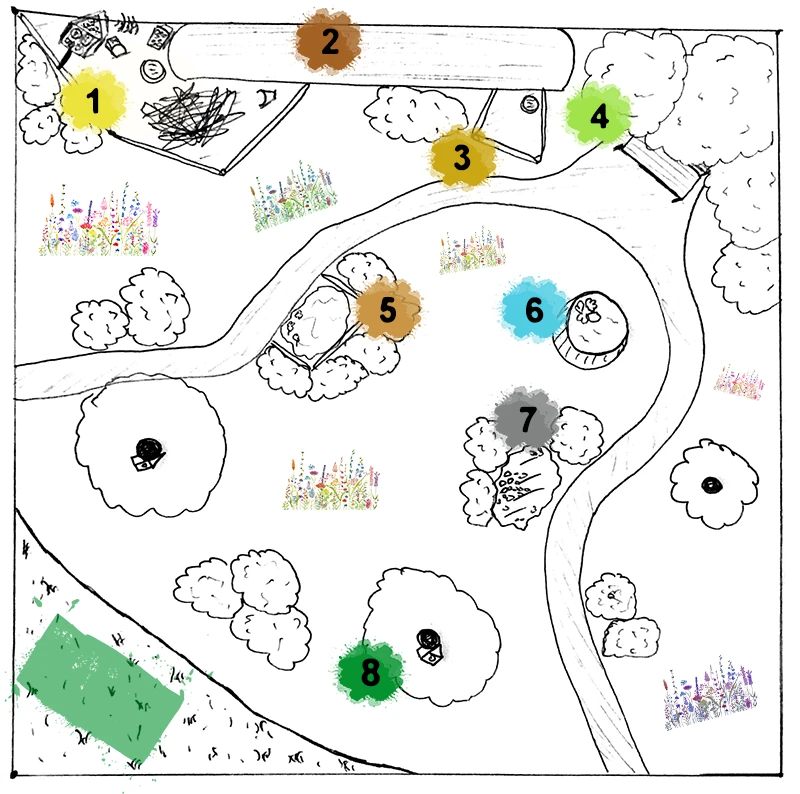
Now you've learned the definition, the benefits, and plenty of tips for creating a wildflower corner in your garden. But what does the wild corner in practice out? What is the best way to divide them?
Basically, it is first important to know that a Wildflower meadow can not be too big and not too small. Because garden animals will come anyway - the size and the offer only decide which animals come. Your project is therefore worthwhile regardless of the size of your garden. You can give free rein to your creativity and constantly optimize the corner.
I've just drawn you a little sketch above where you can see an example layout of a possible wildflower corner. You don't have to implement it exactly like that, of course. Just use it for inspiration and orientation.
Here is the legend that goes with it:
- Sand area with insect hotel, nesting stones, clay pots and water bowl
- Lying deadwood log and deadwood pile
- Sand bath and water bath for birds
- Bench with insect and bird friendly bushes and shrubs
- Piles of leaves and other shrubs and perennials
- Wine barrel converted into mini pond
- Pile of collected field stones and old bricks
- Large trees with nesting boxes
Create wildflower corner in the garden? No problem!
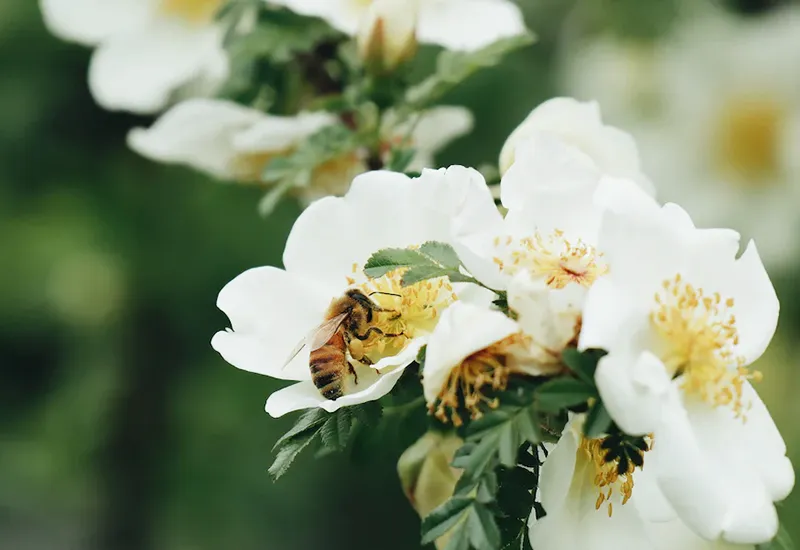
A wildflower meadow or wild corner in the garden is so extremely easy to create and is really so much more than just a visual highlight. It's a statement! A clear sign that you as a garden owner:in Responsibility for our environment and make an active contribution to the protection of biodiversity and local wildlife.
By creating this natural space with countless wildflowers and a variety of textures, you counteract the lifeless, dreary gravel gardens and offer numerous animals a home right on your doorstep.
"The earth laughs in flowers."
Ralph Waldo Emerson (more at Garden Quotes)
Finally I would like to give you at this point additional blog posts for you where you can find even more inspiration and ideas:
- Bee pasture garden - How to do it!
- Design a bird friendly garden
- Sustainable gardening - The best tips
- Protect birds from hitting the window pane
I hope this post has inspired you to create a wildflower corner in your garden. Do you have any questions, suggestions, or more ideas ready to help us all have the most nature- and wildlife-friendly garden possible? If so, I look forward to your comments!
Stay environmentally friendly,

PS: By the way, even without a garden you can do something for Biodiversity and biodiversity! How this works, you will now learn next in the article about a sustainable and environmentally friendly balcony.

